
Brendan Gahan
US
en
Followers
122.5kAverage Views
11.9kEngagement Rate
8.1%Performance
Related Profiles

Formula The K factor can be calculated using the formula: K = i X c Where: i = the average number of invitations sent by each existing user. C = the conversion rate of these invitations (i.e., the percentage of invitations that successfully turn into new users). Interpretation K > 1: The product or service is experiencing viral growth, as each user is bringing in more than one additional user, leading to exponential growth. K = 1: The user base is stable, with each user replacing themselves with one new user. K < 1: The product or service is not achieving viral growth, as each user brings in less than one new user, leading to a decline in user base over time. The "K factor" is a concept used in viral marketing to quantify the growth rate of websites, apps, or a customer base. It's a measure of how many new users, on average, an existing user is able to bring in through referrals. The K factor is a crucial metric in understanding the viral growth potential of a product or service. Here's a breakdown of the concept: Definition The K factor formula is derived from the basic reproduction number in epidemiology, denoted as R0 (R-naught), which measures the number of cases, on average, an infected individual will cause during their infectious period in a population with no immunity. In the context of viral marketing, it translates to the number of new users an existing user can convert or refer. Importance in Viral Marketing The K factor is a vital metric for businesses relying on viral mechanisms for growth. It helps in understanding the effectiveness of referral programs, social sharing features, and other strategies designed to leverage existing users to attract new ones. A high K factor indicates a strong viral growth potential, reducing the need for traditional advertising and significantly lowering customer acquisition costs. Improving the K factor involves enhancing both the number of invitations sent out by users and the conversion rate of these invitations. This can be achieved through optimizing the user experience, making the referral process as seamless as possible, and providing incentives for both the referrer and the referee. #kfactor #viralmarketing101 #socialmediamarketingtips #socialmediamarketingagency #shareability
3.5k
6.06%

Heres the site info👉 ads dot tiktok dot com forward slash business forward slash creativecenter TikTok Creative Business Center provides a ton of resources: TikTok For Business Creative Center is a free, public home to an ever-growing suite of creative resources where you can discover the latest trends, ad examples, best practices, and tools to create quality and effective TikTok ads. Creative Center includes the following sections: 1. Top Ads Top Ads Dashboard is a collection of high-performing creatives that can be filtered by Region, Industry, Campaign Objective, and more. Dive into any Top Ad to learn more about its performance, including a second by second, frame by frame graph to help you easily find the most successful engagement moment in the video. Top Ads Spotlight is a curation of standout ads from the Top Ads Dashboard, handpicked by TikTok creative experts. Regularly check out this page to see the latest expert picks. 2. Keyword Insights Keyword Insights is an insights tool that highlights top keywords and phrases from TikTok ads to inspire users with ad copy and creative messaging ideas. Filter by Region, Industry, and more to discover top-performing and commonly-used keywords, notice how those keywords were used in the context of ad copy, and view real ads that used those top keywords. Use Keyword Insights to discover ways to articulate your business's value proposition, and save time and resources when ideating for your next TikTok ad. 3. Creative Insights These are data-backed ads insights to help you understand which elements in a creative make the difference. Creative Patterns helps you know which video styles, visual elements, and components are driving performance. Best Practices are core creative insights for developing effective TikTok ads. These best practices are based on research and are the fundamentals for making TikTok-ready ad creatives. Consider these tips when building your next TikTok ad or when optimizing existing creatives. 4. Top Products Top Products highlights trending products featured in TikTok ads to help advertisers identify which products to showcase in their creatives. Browse commonly-featured and top-converting products in your respective region/country and category, and also see real ad examples that feature the product. Trends Looking for the latest TikTok trends? Trends displays trending hashtags, songs, creators, and videos by region and industry. Learn what's hot to get a true sense of the pulse and culture of TikTok overall. Track and leverage trends to see how you can tap into what's trending on TikTok in your organic and paid messaging strategies. And a TON of other tools🤙 #socialmediamarketingagency #adagencytips #tiktoktools #discovertrends #tiktokcreativecenter
8.1k
8.3%

Isn't working with creators/influencers risky? It's one of the questions I get most from people outside the industry. Sure, creators are often the focus of controversy. And, there's a level of risk in working with any personality - celebrity, athlete, actor, etc. However, I'd argue it's safer to work with creators. Why? Unlike most 'traditional' celebrities, you actually know a great deal about these personalities. Most influencers share hours, days, weeks, and even years of footage of themselves. You know their likes/dislikes. The relationship they have with friends and family. The brands they buy. How they talk to others. It's not everything, but the level of insight you have into how they behave is exponentially higher than their 'traditional' media counterparts. As a result, I'd argue its generally safer (and easier) for a brand to understand what type of personality they're getting into business with. Why do you think? #influencermarketingagency #influencermarketingadvice #influencersvscelebrities #adagency
1.4k
6.09%

What's the story behind Temu? They bought 3 ads during the Super Bowl and moved up one spot in the app store rankings. How does a 'new' company afford to do that? Temu is part of PinDuoDuo - the massive social commerce company/app from China. I've been familiar with PDD for some time but never realized that Temu was under their umbrella. 𝐇𝐎𝐖 𝐁𝐈𝐆 𝐈𝐒 𝐓𝐄𝐌𝐔? Temu is part of PDD's international expansion efforts, so far they've: • Launched in 40+ countries • Spent $2 billion in marketing • Have 63.7 million US users (as of November) 𝐖𝐇𝐀𝐓 𝐈𝐒 𝐏𝐈𝐍𝐃𝐔𝐎𝐃𝐔𝐎? Originally launched in 2015, PDD has reinvented the ecommerce/social commerce space within China. So much so, their valuation has surpassed that of Alibaba, making it the most valuable U.S.-listed Chinese company. Their founder is now the second richest person in China. But, what's so special about PDD? What makes 'just another' ecommerce platform unique? There are three key points of differentiation 👇👇👇 1. 𝐒𝐨𝐜𝐢𝐚𝐥 𝐒𝐡𝐨𝐩𝐩𝐢𝐧𝐠 The core of Pinduoduo's success lies in its team purchase feature, encouraging users to form groups for purchases. This fosters social interaction and drives down prices, making products more affordable and accessible. The platform integrates e-commerce with social networking, leveraging the connectivity of platforms like WeChat. By integrating with social media platforms Pinduoduo is able to grow organically via traffic driven by social/referrals. 2. 𝐆𝐚𝐦𝐢𝐟𝐢𝐜𝐚𝐭𝐢𝐨𝐧 Pinduoduo gamified much of the shopping experience - you can earn discounts by sharing discounts. BUT, it also literally incorporated games to increase the stickiness of the platform. There's a game, Duo Duo Orchard, where participating in platform activities rewards users with real world points that can be used towards purchases. 3. 𝐋𝐢𝐯𝐞-𝐒𝐭𝐫𝐞𝐚𝐦𝐢𝐧𝐠 Incorporating live streaming (not unlike what we're starting to see within TikTok creates a more dynamic shopping environment where users can interact with sellers in real-time. It adds an entertainment layer to e-commerce but also allows users to ask questions, see what a product is actually like, etc. 𝐂𝐡𝐢𝐧𝐚 & 𝐒𝐨𝐜𝐢𝐚𝐥 𝐂𝐨𝐦𝐦𝐞𝐫𝐜𝐞 You can draw a lot of parallels between PDD + Temu and Bytedance (w Douyin) + TikTok. PDD integrated social, gamification, and shopping to create a new ecomm experience. Douyin/TikTok unbundled the social graph (making content interest based vs connection based) to create a new social media experience. Additionally, Bytedance spent heavily to enter into the US market (estimated $1 billion ayear). Once it had traction it expanded its feature set drastically - mirroring a lot of the features that made Douyin so unique (like live shopping). If Temu goes mainstream here, I'd imagine a similar approach - slowly adding more of what makes PDD so sticky (ie more gamification and social shopping features added). In China, social commerce has witnessed significant growth over the past 5+ years. Live commerce, in particular, emerging as a major driver of spontaneous purchases. So far, China has been the tip of the spear on this front and I see no reason why these features don't see mainstream success in the states (whether via PDD/Temu) or some other app. Curious what others think? Any reason it won't have the same level of success here in the US? #socialmediamarketing #superbowlcommercials #temu #socialcommerce
21.4k
0.9%

What makes you truely valuable working in social media is not your ability to be always on, respond to every post or create a ton of content. What makes you valuable is becoming incredibly good at identifying emerging and untapped opportunities to ride a tidal wave of growth. Getting outsized gains. To do that, you have to immerse yourself in the platforms and have a foundational understanding of human behaviors and psychology. What is industry hype and what’s got real momentum? To do this don’t follow whatever some guru is saying Arm yourself with the ability to make your own judgements by reading obscure psychology studies, books about trends and hypecycles of the past. Study what successful creators did in the beginning and try to reverse engineer their growth tactics- what did their first post look like? Study the nuances of each platform. Creep on the subreddits. Take meetings with new vendors and play with each new platform. The way to develop this muscle, of how to do much more with much less, is by exposing yourself to more than anyone else. One year into my career I was working at a small agency in san francisco This was 2006 - Social media was brand new - you needed a college email just to access Facebook. There were no influencer marketers or social strategists. I was a jr account executive who had no business pitching ideas. But, one day I overheard the partners at the agency talking about how they were turning down a small client who didn’t have a big budget. They couldn’t afford to make a TV commercial or buy billboards so it wouldn’t work. I spun around and told them I had an idea of how we could get these kids on youtube to make something for us. That we should pay them to include that client into a video. We ended up taking that idea to the client and to those youtubers and did one of the first (if not the first) influencer deals on youtube. It crashed the client’s website and got millions of views. That helped me get a job at another agency where we continued to work with hundreds of creators - often cutting them their first checks, wracking up millions of views, and even getting a few of them integrated into super bowl campaigns. Years later I started my own influencer marketing agency which was acquired. Now - this is the part of the video where you’re probably expecting me to say that you must do influencer marketing. But, I’m not. Although its great. My question is - Do you have the tools to identify what the next big opportunity is? Do you think you know what’s next? Can you see what others don’t? Tell me down below. #socialmediamarketing #socialmediamarketingagency #influencermarketingadvice
24.5k
3.81%
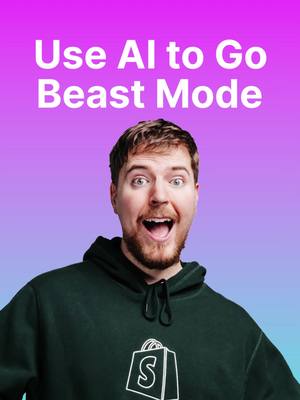
Mr Beast hit 200 million subscribers by dubbing his videos in 15 different language Now you can do the same thing Check it out: This app just hit #3 in the App Store and supports 45 languages, including: Korean, Russian, German, French, Spanish, Italian, Portuguese, Japanese and more. It even changes how your lips move. How’s it look? How do I sound? Pretty cool right? It even lets users translate videos into Texas slang, Gen Z, pirate and baby talk. No lie. #lipdub #mrbeastdubbed #dubbing #captions #autotranslate
13.7k
5.26%
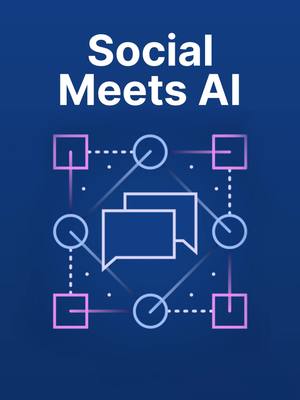
Thanks to @Sprout Social for sponsoring this video Sprout’s AI and automation helps you go beyond repetitive processes to focus on what matters most; the creativity and strategic thinking no machine can emulate. Sprout’sAI and automation is paired with more than ten years of historical social data sets to elevate insights and deliver precise recommendations. Product overview– AI Assist: Create high-quality captions in seconds: With Suggestions by AI Assist, break through writer’s block, inspire new ideas and enhance your post copy. Write robust customer responses at scale: With Enhance by AI Assist, minimize manual efforts and speed up responses to customer messages and care tickets with AI-powered tone and length edits. Find the key learnings essential to your strategy: With Queries by AI Assist, capture the most important conversations by adding AI-suggested keywords to your listening query. Optimal Send Times: Increase the impact of your social strategy. Maximize the reach and impact of your posts by recommendations on the best times for each platform based on past performance and networks trends. Sentiment Scoring: Discover business-critical insights. Understand consumer emotions around key topics and conversations with Sprout’s proprietary Sentiment scoring model.
11.7k
5.39%

When Twitter debuted at South by Southwest in March of 2006, it experienced a 200 percent increase in daily traffic skyrocketing from 20, 000 to 60, 000 tweets in just a couple of days. Every year, SXSW serves as the launchpad for breakthrough technologies and trends. So what's going to be the big trend there this year? I'm no Zuck or Dorsey, but I believe LinkedIn is the next big frontier in influencer marketing. LinkedIn has experienced a meteoric rise amongst creators over 1.5 million pieces of content are shared every minute. Video is the fastest growing format on the platform with uploads up 34 percent year over and they've launched tools to support creator brand partnerships. I'm hoping to speak about these topics, but I need your help. The final panel selection at SXSW is heavily influenced by public votes. 30 percent to be exact. So if you could do me a solid and visit SXSW panel picker site search for my name (brendan gahan) and upvote my panels, I would be incredibly grateful. It only takes 30 seconds. Thank you so much.
2.1k
6.51%
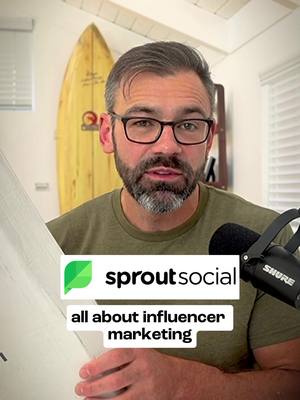
According to a 2023 Goldman Sachs study, over 50 million people worldwide now work as ‘creators.’ I recently partnered with Sprout on this campaign that explores what it means to be a creator. #sproutsocialpartner The goal is "to peel back the curtain on some of the topics that influencers and creators don't always share with their audiences, and we want to help connect you with your own audiences by way of this campaign." So, what was most revealing for me? Oddly, I don't think of myself as a creator or influencer (despite having 150K+ followers across my social accounts). I imagine a lot of people feel that way. In 2011, Mark Zuckerberg predicted that people would share twice as much online every year. This claim, now known as ‘Zuck’s Law,’ seems to be coming true. Being an ‘influencer’ is the most sought-after career among teens. It’s only a matter of time before the venn diagram between creators and everyone else virtually overlaps. Eventually, the lines will blur, with little to no distinction remaining. My participation on social platforms stems from professional necessity and a desire to understand their nuances, connect with emerging creators, and engage with industry peers. I'm a 'social media ad guy' creating as a means to an end. I imagine its the same for a lot of people. You create to understand and in a world where sharing is becoming the norm, the role of influencer and audience is destined to merge. ------ Thanks so much to @Sprout Social for inviting me to participate in this campaign. hashtag #sproutsocialpartner This was a lot of fun🙂 PS: For the surf nerds out there, the boards on the walls are (from left to right): - Old JJF/Pyzel Pipe board - One of MF's old DHD's - Autographed AI shaped by JS - CI autographed by KS - Shaun Tomson (shaped & signed by him)
5.7k
11.44%
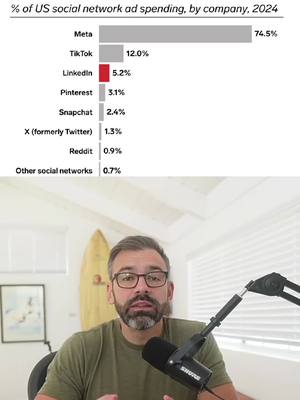
According to eMarketer, "LinkedIn will rank a distant third this year when it comes to share of social ad revenues." But, is that going to last? I don't think so... 1) Engagement Is Way Up eMarketer identifies several growth drivers for LinkedIn, including users fleeing X, targeted investments in creators, algorithm improvements, and its emergence as a news hub. These efforts have led to a: 10.9% increase in time spent since 2021 41% increase in posts (Spring 2023 vs 2021) 2) Growing Gen Z Audience: GenZ has become the fastest growing audience on LinkedIn. In 2024, its estimated that there are: 21.1 million US Gen Z users 13.6% increase year-over-year Gen Zers are finding the professional atmosphere refreshing. It has become a respite from the "overly curated or snarky posts common on other social networks." At the same time they're viewing the platform as more than just a professional connections platform. As a result, the usage has changed. There are more personal stories, entertainment, and news being shared and consumed. 3) Influencer Marketing Tools: LinkedIn has significantly enhanced its influencer marketing capabilities, positioning itself as a formidable platform for brand partnerships and influencer campaigns. Additionally, in 2023, LinkedIn introduced the ability to tag posts as sponsored, increasing transparency and aligning with best practices in influencer marketing. In March of this year, LinkedIn expanded the role of Thought Leader Ads, a feature initially launched to amplify employee content. This capability has now been broadened - now advertisers "can sponsor content from any member—not just employees". These ads have shown impressive results, averaging: 1.7x higher click-through rate (CTR) 1.6x higher engagements According to eMarketer social media ad spends per platform in 2024 is projected to be: Meta: 74.5% TikTok: 12.0% LinkedIn: 5.2% Pinterest: 3.1% Snapchat: 2.4% X (ie Twitter): 1.3% Reddit: 0.9% Other Social Networks: 0.7% Yet, 70% of marketers believe LinkedIn delivers a positive ROI (placing it ahead of YouTube and Instagram). So, while LinkedIn may be third place in ad dollars, it is first place in marketer ROI. And, LinkedIn’s real power lies in its impact. With unparalleled engagement and a booming Gen Z presence, LinkedIn is set to shape the next era of influencer marketing.#linkedin #influencermarketing #linkedininfluencermarketing #b2binfluencermarketing
1.4k
7.53%
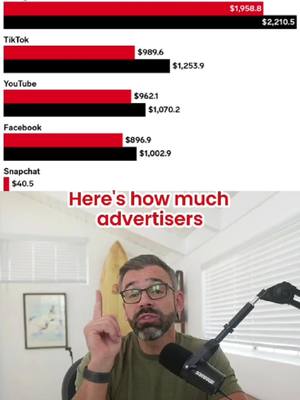
Why the surge in interest around LinkedIn influencer marketing? Here's an in-depth look... According to emarketer, US Influencer marketing spend by platform this year is expected to be: Instagram - $2.2 billion TikTok - $1.3 billion YouTube - $1.1 billion Facebook - $1.0 billion Snapchat - $41.9 million Notably, LinkedIn doesn't even make the cut? So, why are we, at Creator authority, so bullish? And, why the recent hype and interest in this space? We're reaching a tipping point. Here's why... Community Growth: LinkedIn's strategic investments in the creator ecosystem have paid off. Content creation has surged: 41% increase in public posts (2021-23) 24% YOY increase in public posts (2022-23) 150K newsletters have been launched Qualified Audience: LinkedIn recently hit 1 billion users, with over 200 million in the US. They're highly affluent AND have big impact within B2B: 80% of B2B marketers use LinkedIn ads 4 out of 5 people on LinkedIn “drive business decisions” 1.36 times more affluent than those on Facebook Platform Support Last year LinkedIn launched a number of tools to support creator-brand partnerships, including the brand disclosure tool. This year they expanded the capabilities of Thought Leader Ads (their version of a promoted post tool) so that advertisers "can sponsor content from any member—not just employees". Notably, these are wildly effective performing much better than traditional ads (1.7x lower CPM's and 1.6X higher engagement rates). Trust: LinkedIn has been the #1 most trusted platform by brands for years. Unlike other social media platforms, LinkedIn has avoided major brand safety issues like adpocalypse, boycotts, and controversies. In an era of brand safety concerns this is a huge advantage for the platform. Efficacy: LinkedIn places a greater emphasis on deeper/narrower connections. In an era where platforms are chasing the interest based graph (a la TikTok's FYP), LinkedIn is doubling down on the professional graph. It means depth vs breadth. Over the last year, users have seen a 10% increase in people viewing posts from their followers. This is because LinkedIn prioritizes meaningful connections and professional relevance. This plays out in the impact of campaigns - much higher CTR's, engagement, and lead acquisition than other platforms where follower counts, and connections to creators mean far less. With a booming audience, robust community growth, and a powerful new tool set, LinkedIn isn't just joining the influencer game. It's the untapped goldmine of influencer marketing.
1.3k
8.66%

You may never go viral on LinkedIn (and here's why that's actually a good thing) Longtime LinkedIn users have noticed a decline in organic reach. An evaluation of 1 million posts by Richard van der Blom revealed a 66% drop in organic reach from Oct '22 to Oct '23. This isn’t a fluke. In interviews with Jason feiffer, LinkedIn's deliberate efforts to suppress growth hacking were discussed. LinkedIn's Editor-in-Chief stated, "When things go viral on LinkedIn, usually that's a sign to us that we need to look into this, because that's not celebrated internally." But in an era where other platforms are increasingly becoming 'Million Follower Factories,' why is LinkedIn doing the opposite? And how is that beneficial to you? SOCIAL VS INTEREST-BASED GRAPH Over the last year, users have seen a 10% increase in people viewing posts from their followers. This is because LinkedIn prioritizes meaningful connections and professional relevance. Contrast this with the shift on other platforms. TikTok's FYP introduced the world to algorithmically recommended content, making engagement independent of social connections. In 2022, TikTok had over 40k accounts with a million followers. Instagram’s CEO, Adam Mosseri, even stated that follower counts now matter less than views and likes. These platforms provide more social capital than financial capital. Eugene Wei described them as offering "Status As A Service," catering to our "status-seeking monkey" nature. They’ve become arenas where hyperbole and sensationalism reign supreme, constantly chasing likes and views. As a result, followers are devalued due to influencer inflation. CONTRAST WITH LINKEDIN LinkedIn stands out by emphasizing community and fostering deeper, more meaningful connections. LinkedIn's vision is to "create economic opportunity for every member of the global workforce." This contrasts sharply with the social capital focus of other platforms. On LinkedIn, the emphasis is on financial capital – fostering professional growth and economic opportunity through authentic connections. On LinkedIn, followers actually matter. Other platforms are suffering from influencer inflation, but on LinkedIn, you are part of a lasting professional community. So, while you may never go viral on LinkedIn, it's not about the quantity of followers but the quality of connections.
1.3k
7.18%

In June 2010, Old Spice's 'The Man Your Man Could Smell Like' changed the course of social media and advertising. Created by Wieden & Kennedy, it took the ad world by storm, winning the Grand Prix Award at the Cannes Lions International Festival of Creativity. It was also a game-changer for social media advertising. It highlighted the power of YouTube. Although, the campaign premiered during the Super Bowl it had longevity online: • Holding 8 of top 11 most-popular video spots on YouTube • Generating 40+ million views • Boosting body wash sales by 107% A few weeks later, the very first VidCon was held from July 9–11, 2010, at the Hyatt Regency Century Plaza hotel in Los Angeles. That first event had 1,400 attendees. and what began as a small gathering of creators and their fans has grown to tens of thousands of attendees each year. I've attended every VidCon (in the US) since its inception. This past year, I also experienced my first Cannes Lions Festival (thanks @sprout Like many in social media and influencer marketing, I've always wondered why influencers haven't historically been priority for the industry. So, I tried to put it into perspective from a macro standpoint: • 2023 was the first time digital video outpaced traditional TV • Influencer budgets are growing (up 14% YOY) But, there's room for growth. 2024 Estimated Ad Revenue Allocations: • $926 billion overall • $247.3 billion on social media • $35.1 billion on influencer marketing (less than 4%) While creators account for less than 4% of ad dollars. They're having an impact. According to @sproutsocial's 2024 Influencer Marketing Report, "49% of all consumers make daily, weekly, or monthly purchases because of influencer posts, and 30% of consumers trust influencers more today than they did six months ago." So, while influencer marketing represents a small fraction of overall ad spending, there is still so upside. We're early (in the grand scheme of things). Regardless, brands that embrace creators will have an outsized impact. John Green, co-founder of VidCon, eloquently expressed this sentiment during his 2015 Brandcast address to advertisers: "By supporting creators through advertising, we can build and nurture more diverse communities. If we can count on your support, we'll have more time to develop deeper relationships with our audiences, which ultimately leads to stronger connections with your brands." 🌱thanks Sprout for sending me to Cannes! #sproutsocialpartner 📌 The integrations of @Sprout Social’s Influencer Marketing Platform makes them a great all in one solution for everything from community management, to social listening, and now influencer discovery with centralized (and simple) reporting. #canneslions2024 #vidcon2024 #vidcon
2.4k
5.35%

This is Matty Mo, known as "The Most Famous Artist," a Los Angeles-based artist and marketing innovator who's redefining the intersection of art, technology, and society. With a background in advertising technology and an education from Stanford University, Matty embarked on his artistic journey in 2013, creating thought-provoking installations, performances, and exhibitions that reflect on our digital era. Through his project "The Most Famous Artist," Matty engages audiences by transforming traditional paintings with contemporary elements, drawing inspiration from art legends like Marcel Duchamp and Andy Warhol, yet infusing his works with a modern twist through digital promotion and social media engagement. Highlights of his career include "100 Thousand Dollars" (2016), where art mimicking stacks of cash sold out on Instagram in minutes, and "The Pink House" (2017), a visual commentary on gentrification that captured widespread attention online. His exploration of art and technology continued with collaborations on AI-generated art and socially critical projects like "The Private Jet Experience" and "The Fyre Experience," which comment on the illusion of luxury and the absurdities of social media culture. Matty Mo's work extends beyond individual projects; he contributes to the broader conversation on art and technology through public speaking and has been featured in major publications and news platforms. His approach not only critiques but also celebrates the complexities of the digital age, positioning him as a pivotal figure in contemporary art. — here’s the transcription of our conversation, the full conversation is one of several interviews with innovators, influencers, and agency execs available in my course (you know where to look for that)👇👇👇 And people started replicating these monoliths all over the place. So the story kept getting bigger. And because I was the person that broke that second cycle, I was able to perpetuate the story. Did I do the monolith? No. Did I get credit for all of the monoliths and garner hundreds of millions of media impressions and interviews with mainstream media? This is matt - aka The Most Famous Artist AKA the guy behind those viral Pink Houses in LA, The Selfie Wall in Venice, and a ton of street art He’s part marketer part provocateur And you remember that mysterious Monolith that went viral in 2020? Here’s the story of how he leveraged that hypecycle to go viral, start selling his own monoliths for a whopping $45,000, and what social media marketers can learn from his tactics A monolith appeared in the desert of Utah, and it was, like, perfect, and people were speculating it was aliens, and all this news started happening. Now, talk about me penetrating a news cycle again, so that news spun up, I was like watching this happen and I thought it was funny and people were speculating it was aliens. And there was lots of memes going around and it occurred to me . I have a studio. I could make a monolith and I could take pictures of me installing a monolith. And I could send this anonymously to a news agency give them enough evidence that it could have been me for them to run the story and then have a call to action there. And my call to action was the viral piece, which was it definitely was not not me. I definitely don't not have a studio that could do this. You definitely will not see more of these popping out all over the world and aliens exist. And that just made people go apeshit. If you're on a social team, you're looking out for real time moments. You've got some resources for people working in an office. We've seen an opportunity that maybe seems somewhat related to their brand. What advice would you give them? Figure out the, minimum viable execution to be able to do it, do it fast make it legit enough, but don't overthink it and react in real time. So much of good marketing is just brute force. Very little of it as an optimization. @The Most Famous Artist
3.9k
10.06%
Technology
Fastest Growing





